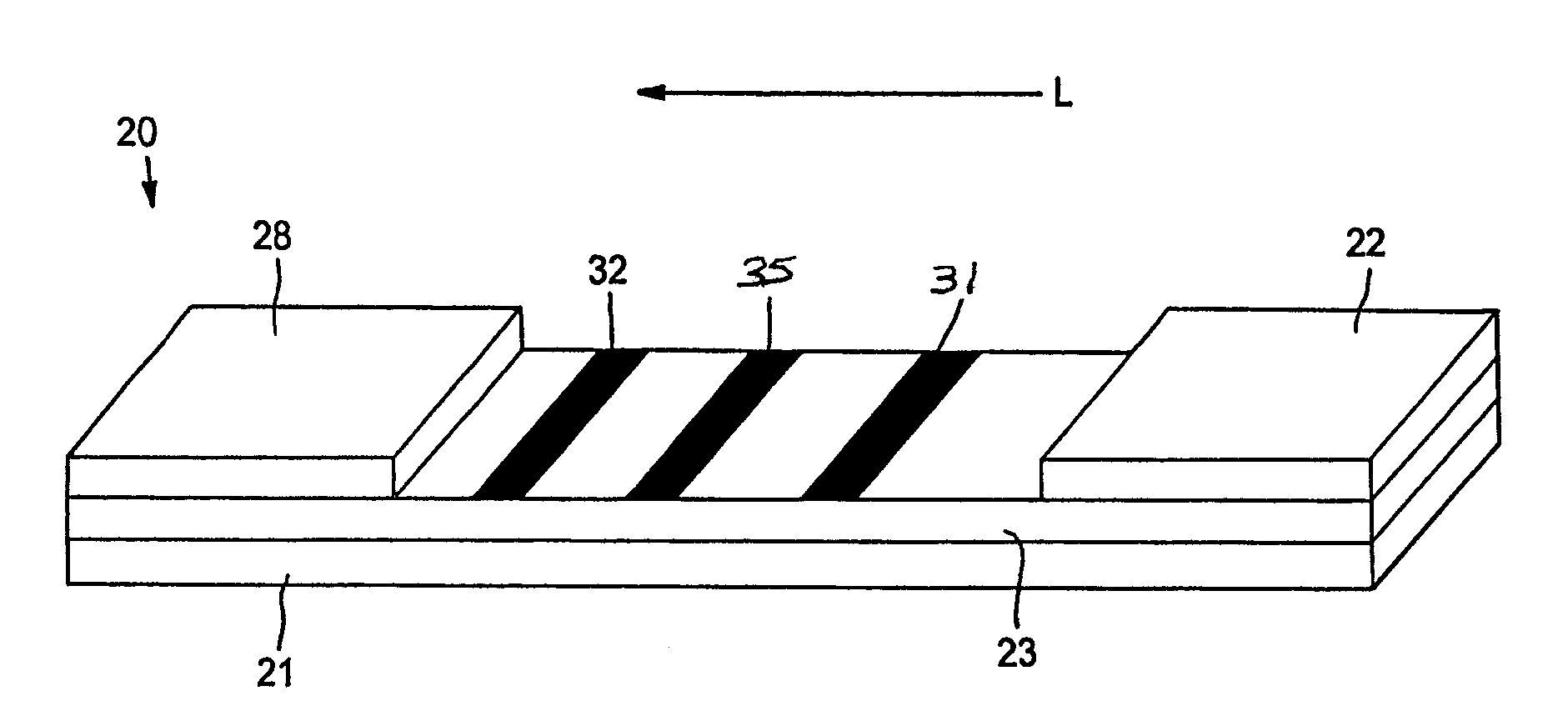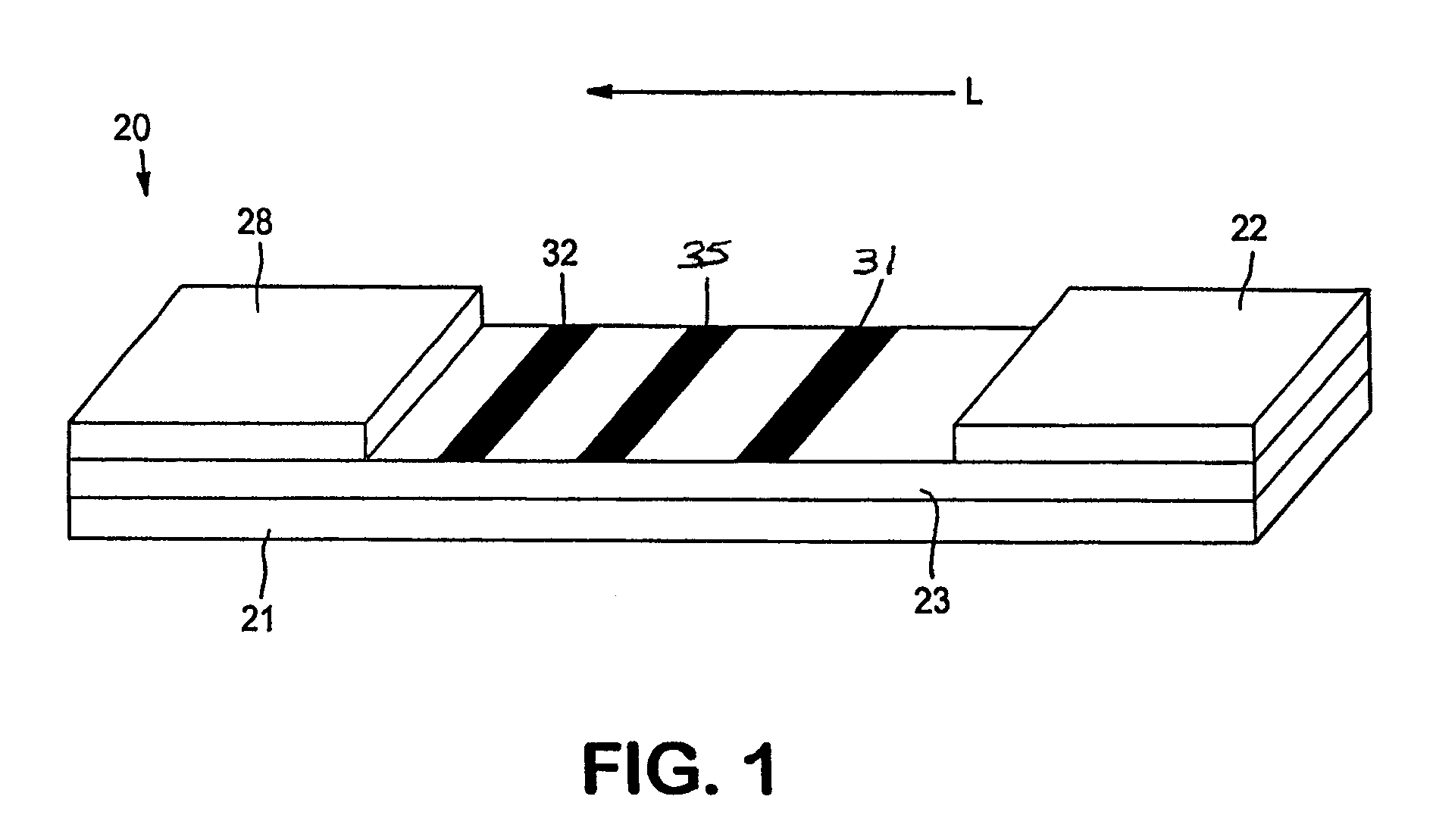Assay devices having detection capabilities within the hook effect region
a technology of detection capability and hook effect, which is applied in the direction of material analysis by observing the effect of chemical indicators, instruments, biomass after-treatment, etc., can solve the problems of inability to detect and many conventional lateral flow assays encounter significant inaccuracy
- Summary
- Abstract
- Description
- Claims
- Application Information
AI Technical Summary
Benefits of technology
Problems solved by technology
Method used
Image
Examples
example 1
[0076]The ability to form a lateral flow assay device was demonstrated. A nitrocellulose porous membrane (HF 120 from Millipore, Inc.) having a length of approximately 30 centimeters was laminated onto supporting cards. Monoclonal antibody for C-reactive protein was immobilized on the porous membrane to form a detection zone. The antibody was obtained from BiosPacific, Inc. (Catalog #A58040136P) and had a concentration of 1 milligram per milliliter. CRP antigen was immobilized on the porous membrane to form an indicator zone. The antigen was obtained from Biogenesis Inc. of Kingston, N.H., and had a concentration of 2.78 milligrams per milliliter. Goldline™ (a polylysine solution obtained from British Biocell International) was striped onto the membrane to form a control zone. The indicator zone was positioned between the detection zone and the control zone. A cellulose wicking pad (Millipore Co.) was laminated with one end (closer to the control zone) of the membrane. The membrane ...
example 2
[0078]Lateral flow devices were formed as described in Example 1, except that 2.23 milligrams per milliliter of goat anti mouse IgG (Fc) was used to form the control zone.
example 3
[0079]The ability to form a lateral flow assay device was demonstrated. A nitrocellulose porous membrane (HF 120 from Millipore, Inc.) having a length of approximately 30 centimeters was laminated onto supporting cards. Monoclonal antibody for C-reactive protein (BiosPacific, Inc., Catalog #A58040136P) in 0.1% trehalose aqueous solution was immobilized on the porous membrane to form a detection zone. CRP antigen was immobilized on the porous membrane to form an indicator zone. The antigen was obtained from Biogenesis Inc. of Kingston, N.H., and had a concentration of 2.78 milligrams per milliliter. Goat anti alkaline phosphatase (2.5 milligrams per milliliter, obtained from Fitzgerald Industries International, Inc. of Concord, Mass.) was striped onto the membrane to form a calibration zone. The indicator zone was positioned between the detection zone and the calibration zone. A cellulose wicking pad (Millipore Co.) was laminated with one end (closer to the control zone) of the membr...
PUM
| Property | Measurement | Unit |
|---|---|---|
| concentration | aaaaa | aaaaa |
| size | aaaaa | aaaaa |
| optical density | aaaaa | aaaaa |
Abstract
Description
Claims
Application Information
 Login to View More
Login to View More - R&D
- Intellectual Property
- Life Sciences
- Materials
- Tech Scout
- Unparalleled Data Quality
- Higher Quality Content
- 60% Fewer Hallucinations
Browse by: Latest US Patents, China's latest patents, Technical Efficacy Thesaurus, Application Domain, Technology Topic, Popular Technical Reports.
© 2025 PatSnap. All rights reserved.Legal|Privacy policy|Modern Slavery Act Transparency Statement|Sitemap|About US| Contact US: help@patsnap.com



